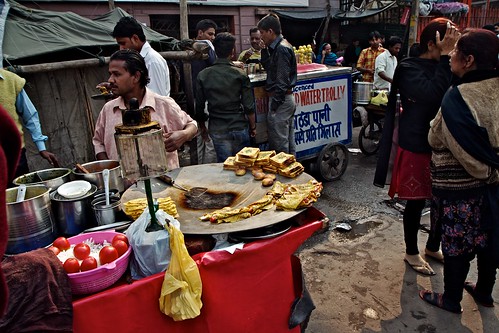
![]() photo credit: zedvox
photo credit: zedvox
Like all people, the citizens of India tend to be gregarious. They enjoy gathering outside the home in the course of daily work, shopping and other tasks requiring a foray into the public areas in every settlement regardless of size or location. Chaos is a strong characteristic of these places where they gather. Cars with horns honking constantly drive through any passage wide enough to accommodate them. Animals are herded through: water buffalo and cattle, camels and goats and elephants surprise no one when they appear. People interact in a blaze of color and movement; haggling, buying, leading and following; eating drinking spitting and sleeping. The deeply imbedded order which defines chaos is felt beneath a cacophony that everyone appears to enjoy. What of the place itself? It is usually a street: squares and plazas are rare, often vestiges of the Raj, These places of former pomp are now quiet save for games of cricket. Whether in their hometowns or at foreign locales within India, the place people gather is the street. They do in the hill stations, in the towns, and the villages just as they do in Bombay and Calcutta. Bazaars are almost always widened streets themselves. These are the people who take their shoes (and the street) off when entering the home, a home with floors washed daily on hand and knee. This is the case with temples as well: barefoot people and spotless floors. But what of the street, the plaza, and roadside, even the common corridors in office buildings? They are squalid and filthy, filled with trash and debris. Along every road, in every town, and in every place Indians gather offal and trash gathers too. The smell is unmistakable, the thing most unsightly, but the people add to it everyday, tossing wrappers out car windows and leaving trash at the site of a picnic. Indians share a dialectical world view with their western neighbors. There is good and evil, beauty and ugliness, happiness and sadness and so on. When one places clean homes and trashy byways in this context their coexistence begins to become clearer. Homes and temples are sacred. Streets and alleyways are profane. Certain activities as well as standards of hygiene probably follow this paradigm. For an urbanist, Indian or foreigner to India, the question is ” Do Indians notice the squalor?” Westerners do not care for it at all: to be neat on the street is a fundamental requisite of their social behavior. Sloppy public behavior is probably not a cofactor of education per se; illiterate people may not be exactly as clean as others, but this may be a function of circumstance rather than world view. Many Indians say that this phenomenon appalls them as well. This group joins the western contingent; the jolly leavers of detritus are in question here. India’s caste system may provide the necessary component of cause and effect for urban detritus. This system has a group at the top, lots of groups in the middle, and a group at the bottom. This last group, the “untouchables” , are still considered unclean and are assigned the most unpleasant work in Indian society. Many members of this caste are found in public areas for the simple reason that they have poor lodgings to return to or have no lodgings at all. To a culture with caste present for over a thousand years, beliefs persist despite public hue and cry against them. It is similar to racism to the effect that even the most educated person says and wishes he were not racist. Deep down tough, there is a primitive urge that is very hard to ignore completely. Indians have abolished caste, and there are political and commercial successes for persons of low caste as a result. Old habits die hard. Persons of the underclass especially in the cities are dirty themselves, untouchable by both cultural and hygiene standards. It is not entirely unlikely that this group has always lived in a variation of where and how it now lives, and has been avoided for similar reasons for an equal amount of time. In Indian society people of every stripe comingle frequently. There is a tolerance for what more Cartesian societies would call “vagrancy”. People hang about everywhere. In essence the street is the home of the underclass and the “lowest” space in Indian culture. I would speculate that this sentient is a very old one, and that India did not begin leaving debris around recently. Perhaps it is as old and tenacious as the caste system, and will be as resistant to change.
